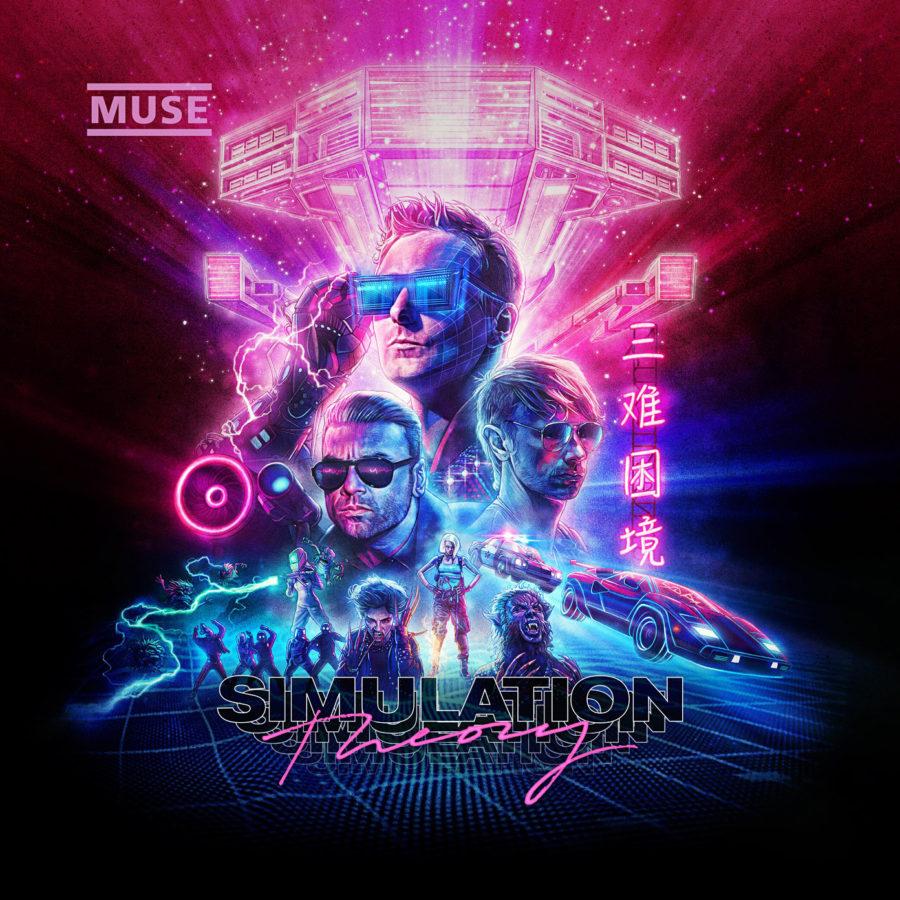‘Simulation Theory’ takes Muse back to the future
The cover artwork for “Simulation Theory” was drawn by Kyle Lambert, best known for his work on Netflix’s Original Series, “Stranger Things.”
November 11, 2018
Muse rides in on bombastic synthwave to completely reinvent their image with “Simulation Theory.”
Nearly 20 years after “Showbiz,” their debut album, Muse declares they’re not to be forgotten with their latest release. 2009’s “The Resistance” saw the English rock band lose their edge, shifting into a borderline-parody of Queen with only half the charm. “The 2nd Law” only continued the downward trend as frontman Matt Bellamy spiraled into dubstep-laden experimental failure.
During this time, Muse received flak from critics and fans alike, as they lost sight of their space-themed, angst-driven roots as a more traditional rock band. 2015’s “Drones” tried to please new and old fans alike, but resulted in a mess of childish, politically-charged heavy metal.
Of the five singles dropped prior to “Simulation Theory,” few inspired confidence that Muse would recover their reputation with their newest album. Bizarrely enough, they withheld their most exciting songs for its final release.
Muse jumps on the 80s pop culture fad popularized by “Stranger Things” and “Ready Player One,” taking their theatrical prog rock sound back to the future with retro synths backed by intense orchestral score. Muse’s already synth-heavy discography primed the synthwave genre as a natural progression for the band to explore.
Bellamy’s lyricism has the reserved intelligence and grace of a bull in a china shop, but has finally gained a twinge of self-awareness. The vocalist unabashedly takes advantage on his own lyrical cliches, proclaiming “This means war/ with your creator!” in opener, “Algorithm.”
The band takes huge risks with experimental tracks like nothing else in their discography. There’s a swagger to Bellamy’s step in “Propaganda,” intimately whispering verses between gaudy and in-your-face “Pro-po-po-poganda’s.” Hip-hop/Arabian fusion, “Break it to Me,” keeps things weird, Bellamy mimicking Tom Morello’s unconventional guitar soloing. While initially off-putting, both tracks are infectiously addictive.
The album stumbles at the mid-way point with a radio-safe love song and generic arena rock. Muse is at their worst in “Get Up and Fight,” a bouncy EDM-style track leading into an anthemic pop punk chorus ripped straight from the worst parts of the 2000s.
“Blockades” delivers the most classically-Muse sound on the album, rescuing “Simulation Theory” from pop radio with chiptune-fueled anger and crunchy guitar. “The Void” closes on grim, but hopeful note, Bellamy crooning over dark synths and piano arpeggios, capped off by reverberating bass flares.
While promoting their 2017 tour, Chris Wolstenholme said in an interview with Music Feeds he wasn’t even sure if Muse had another album in them. The bassist voiced concerns over the way music is consumed in the age of streaming, listeners choosing singular tracks for playlists instead of sitting down for a full-album experience.
The deluxe edition of “Simulation Theory,” available on all streaming platforms, contains alternative versions of nearly every track, almost suggesting a modularity to the release. Fans are able to customize their own album experience by swapping out “Dig Down” with an acoustic gospel version, or “Algorithm” with an “Alternate Reality Version” that wouldn’t sound out of place on Daft Punk’s “Tron: Legacy” soundtrack.
Regardless of the band’s concerns, “Simulation Theory” is their most tonally consistent album in years, showing Muse is still capable of throwing together a cohesive effort. Muse has wiped the slate clean and completely refreshed their image. No longer can they simply be classified as a rock band, but as a music group fearless to produce exactly what they want.







